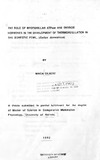| dc.description.abstract | The development of homeothermy was studied in the
domestic fowl by measuring changes in oxygen consumption
(\1°2) and body temperature (Tre; chicks only) with decreasing
ambient temperatures (Ta) during the last week of incubation for
embryos and first week of life for chicks. During the same period,
myofibrillar ATPase (m-ATPase) activity and thyroid hormones
(Thyroxine, T4; and triiodothyronine, T3) were also measured.
\102 for 15, 16, and 17 day old embryos diminished with
decreasing Ta. Embryos at 18, 19, 20 and 21 days, initially
maintained their \102 for decrements of 3, 3, 4, and SOC in Ta
respectively, but their \102 fell with decreasing Ta thereafter.
For chicks, \102 increased with decreasing Ta upto a peak and
then fell with further decrements in Ta. The difference between
the initial and final Tre taken before and after the experiments
decreased as the chicks became older.
Myofibrillar ATPase activity increased with incubation to
reach a critical value in 18 day old embryos and thereafter
undulated about the same level. Both T3 and T4 levels increased
exponentially during the last week of incubation and peaked at
hatching. T4 fell below prehatching levels to a nadir 2 days posthatching
and thereafter rose slowly, while T3 never fell below
prehatching levels. T3/T 4 ratio increased exponentially from day
19 of incubation and peaked 2 days post-hatching.
It is concluded that up to day 17 of incubation, chicken
embryos are poikilothermic and incipient endothermic
homeothermy starts on day 18. At hatching, the qualitative adult
homeothermic response is present and it approximates that of
adults 7 days post-hatching. The strong correlation between \102
and m-ATPase during the embryonic stages and the critical value
of m-ATPase activity attained on day 18 suggests a critical role
for m-ATPase activity in the development of thermoregulation.
Similarly, a stronger correlation between \102 and T3 than T4
within the period of study suggests a greater role for T3 than T4
in the development and maintenance of homeothermy. T3 and T4
also play an important role in the hatching process as indicated
by their peak values then. The increasing T3fT4 ratio suggests
increased conversion of T4 to T3 around the perinatal period. | en |

